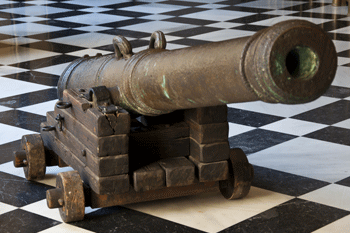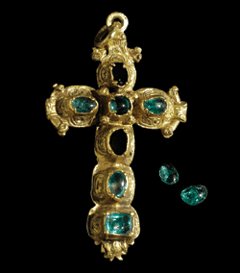|
Atocha
Treasure
Answer
to Name
This Famous Antique Game - November 2016
By Mike McLeod

On September 4, 1622, a Spanish treasure fleet of 28 ships left Havana, Cuba, for Spain. Annually, the fleet carried a wondrous treasure of gold, silver, emeralds, copper, indigo and tobacco. This year’s fleet was six weeks late in its departure due to the late arrival of the treasure and goods from across South America. This spelled the demise of many of the ships because it put them at sea during hurricane season.
Two days into the voyage on September 6th, a hurricane struck the fleet in the Florida Straits. Ships were capsized and sank; the Nuestra Señora de Atocha hit a reef and went down 55 feet to the bottom. Her mizzenmast was broken off during the storm, but the stump showed above water, marking the spot. The Santa Margarita and Nuestra Señora del Rosario ran aground and were stranded. The Atocha carried 265 people, and all but five died. On the Santa Margarita, 142 perished.
|

|
One of the Atocha’s cannons in the Archivo General de Indias" in Seville, Spain. (Photo courtesy of Paul Hermans)
|
At this time, Spain was at outset of the Thirty Years War and it also suffered major losses from Dutch attacks on its shipping. It desperately needed money. To fund the Spanish treasury, the Crown taxed cargo at 20% and laid a second tax which could be up to 40%. Naturally, smuggling was rampant to avoid these taxes, and to combat this, the Spanish government sent a clerk on each vessel to create a manifest documenting what was carried on and off the ship. Even so, treasure was often smuggled onboard.
Thanks to the manifests, it is known that the Atocha was carrying “…24 tons of silver bullion in 1,038 ingots, 180,000 pesos of silver coins, 582 copper ingots, 125 gold bars and discs, 350 chests of indigo, 525 bales of tobacco, 20 bronze cannon and 1,200 pounds of worked silverware.”1 The documented treasure of the Santa Margarita (not including any smuggled treasure) was 9,000 ounces of gold, 166,574 silver coins, 10,000 pounds of silver and much more.
Word of the disaster reached Spain which then began a salvage operation. Diving bells have been used since about the 4th century B.C.2, and the Spanish successfully employed one on the Santa Margarita, recovering about half its treasure. The Atocha was found, but her hatches were battened down too tightly to get inside. When a hurricane struck on October 5, 1622, it scattered the wreck, and the Atocha was completely lost for more than 300 years.
In 1969, treasure hunter Mel Fisher began searching for the Atocha around the Florida Keys. The hunt went on for 16 years and required his team to create special equipment to blow sand from the seabed to reveal any treasure in the search pattern. Along the way, they found tantalizing clues that they were on the right trail, including three bars of silver and five bronze cannon. In 1980, some of the Santa Margarita’s treasure was discovered: “…a fortune in gold bars, jewelry and silver coins.”3
Then on July 20, 1985, Fisher’s son Kane found the Atocha and what became known at the Atocha Motherlode. The $450 million treasure included 40+ tons of silver and gold, 100,000+ silver "pieces of eight" coins, 1,000+ silver bars, gold coins, Columbian emeralds, “…a solid gold belt and necklace set with gems; a gold chalice designed to prevent its user from being poisoned; an intricately-tooled gold plate; a gold chain that weighs more than seven pounds; a horde of contraband emeralds—including an impressive 77.76 carat uncut hexagonal crystal experts have traced to the Muzo mine in Colombia; religious and secular jewelry; and silverware.”4
Salvage and conservation efforts were mammoth, but the legal wrangling was gargantuan. Mel Fisher fought the State of Florida and the U.S. Government about ownership of the Atocha. In the end, the U.S. Supreme Court ruled the shipwreck was in international waters and the property of Mel Fisher’s company.
|

|
A gold and emerald cross from the Atocha shipwreck.
(Photo courtesy of Guernsey’s)
|
In 2015, the gold and emerald cross from the Atocha pictured here was sold by Guernsey’s for $118,750. Mel Fisher passed away on December 19, 1998.
Some of the Atocha’s treasure may be seen in the Mel Fisher Maritime Museum in Key West, Fla., at 200 Greene Street.
------------------------------------
1, 3 Melfisher.org, “Nuestra Señora de Atocha, Santa Margarita, Spanish Galleons of 1622.”
2 Arthur J. Bachrach, "History of the Diving Bell", Historical Diving Times, (Spring 1998).
4 Melfisher.org.
Credits: Wikipedia.org
|